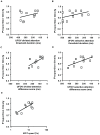Visual attention measures predict pedestrian detection in central field loss: a pilot study
- PMID: 24558495
- PMCID: PMC3928437
- DOI: 10.1371/journal.pone.0089381
Visual attention measures predict pedestrian detection in central field loss: a pilot study
Abstract
Purpose: The ability of visually impaired people to deploy attention effectively to maximize use of their residual vision in dynamic situations is fundamental to safe mobility. We conducted a pilot study to evaluate whether tests of dynamic attention (multiple object tracking; MOT) and static attention (Useful Field of View; UFOV) were predictive of the ability of people with central field loss (CFL) to detect pedestrian hazards in simulated driving.
Methods: 11 people with bilateral CFL (visual acuity 20/30-20/200) and 11 age-similar normally-sighted drivers participated. Dynamic and static attention were evaluated with brief, computer-based MOT and UFOV tasks, respectively. Dependent variables were the log speed threshold for 60% correct identification of targets (MOT) and the increase in the presentation duration for 75% correct identification of a central target when a concurrent peripheral task was added (UFOV divided and selective attention subtests). Participants drove in a simulator and pressed the horn whenever they detected pedestrians that walked or ran toward the road. The dependent variable was the proportion of timely reactions (could have stopped in time to avoid a collision).
Results: UFOV and MOT performance of CFL participants was poorer than that of controls, and the proportion of timely reactions was also lower (worse) (84% and 97%, respectively; p = 0.001). For CFL participants, higher proportions of timely reactions correlated significantly with higher (better) MOT speed thresholds (r = 0.73, p = 0.01), with better performance on the UFOV divided and selective attention subtests (r = -0.66 and -0.62, respectively, p<0.04), with better contrast sensitivity scores (r = 0.54, p = 0.08) and smaller scotomas (r = -0.60, p = 0.05).
Conclusions: Our results suggest that brief laboratory-based tests of visual attention may provide useful measures of functional visual ability of individuals with CFL relevant to more complex mobility tasks.
Conflict of interest statement
Figures


Similar articles
-
Driving with Central Visual Field Loss II: How Scotomas above or below the Preferred Retinal Locus (PRL) Affect Hazard Detection in a Driving Simulator.PLoS One. 2015 Sep 2;10(9):e0136517. doi: 10.1371/journal.pone.0136517. eCollection 2015. PLoS One. 2015. PMID: 26332315 Free PMC article.
-
The Effects of Age, Distraction, and Simulated Central Vision Impairment on Hazard Detection in a Driving Simulator.Optom Vis Sci. 2020 Apr;97(4):239-248. doi: 10.1097/OPX.0000000000001501. Optom Vis Sci. 2020. PMID: 32304533 Free PMC article.
-
Driving with central field loss I: effect of central scotomas on responses to hazards.JAMA Ophthalmol. 2013 Mar;131(3):303-9. doi: 10.1001/jamaophthalmol.2013.1443. JAMA Ophthalmol. 2013. PMID: 23329309 Free PMC article.
-
More than the Useful Field: Considering peripheral vision in driving.Appl Ergon. 2017 Nov;65:316-325. doi: 10.1016/j.apergo.2017.07.009. Epub 2017 Jul 28. Appl Ergon. 2017. PMID: 28802451 Review.
-
Central and paracentral visual field defects and driving abilities.Ophthalmologica. 2005 Jul-Aug;219(4):191-201. doi: 10.1159/000085727. Ophthalmologica. 2005. PMID: 16088237 Review.
Cited by
-
The Multiple Object Avoidance (MOA) task measures attention for action: Evidence from driving and sport.Behav Res Methods. 2022 Jun;54(3):1508-1529. doi: 10.3758/s13428-021-01679-2. Epub 2021 Nov 16. Behav Res Methods. 2022. PMID: 34786653 Free PMC article.
-
Driving with Central Visual Field Loss II: How Scotomas above or below the Preferred Retinal Locus (PRL) Affect Hazard Detection in a Driving Simulator.PLoS One. 2015 Sep 2;10(9):e0136517. doi: 10.1371/journal.pone.0136517. eCollection 2015. PLoS One. 2015. PMID: 26332315 Free PMC article.
-
A link between attentional function, effective eye movements, and driving ability.J Exp Psychol Hum Percept Perform. 2017 Feb;43(2):381-394. doi: 10.1037/xhp0000297. Epub 2016 Nov 28. J Exp Psychol Hum Percept Perform. 2017. PMID: 27893270 Free PMC article.
-
The effects of simulated acuity and contrast sensitivity impairments on detection of pedestrian hazards in a driving simulator.Transp Res Part F Traffic Psychol Behav. 2019 Jul;64:213-226. doi: 10.1016/j.trf.2019.05.003. Transp Res Part F Traffic Psychol Behav. 2019. PMID: 31983886 Free PMC article.
-
A systematic review of extended reality (XR) for understanding and augmenting vision loss.J Vis. 2023 May 2;23(5):5. doi: 10.1167/jov.23.5.5. J Vis. 2023. PMID: 37140911 Free PMC article.
References
-
- Patel RD, Momi RS, Hariprasad SM (2011) Review of ranibizumab trials for neovascular age-related macular degeneration. Semin Ophthalmol 26: 372–379. - PubMed
-
- DeCarlo DK, Scilley K, Wells J, Owsley C (2003) Driving habits and health-related quality of life in patients with age-related maculopathy. Optom Vis Sci 80: 207–213. - PubMed
-
- Timberlake GT, Peli E, Essock EA, Augliere RA (1987) Reading with a macular scotoma. II. Retinal locus for scanning text. Invest Ophthalmol Vis Sci 28: 1268–1274. - PubMed
-
- Verezen CA, Hoyng CB, Meulendijks CFM, Keunen JEE, Klevering BJ (2011) Eccentric Gaze Direction in Patients with Central Field Loss. Optom Vis Sci 88: 1164–1171. - PubMed
Publication types
MeSH terms
Grants and funding
LinkOut - more resources
Full Text Sources
Other Literature Sources
Miscellaneous

